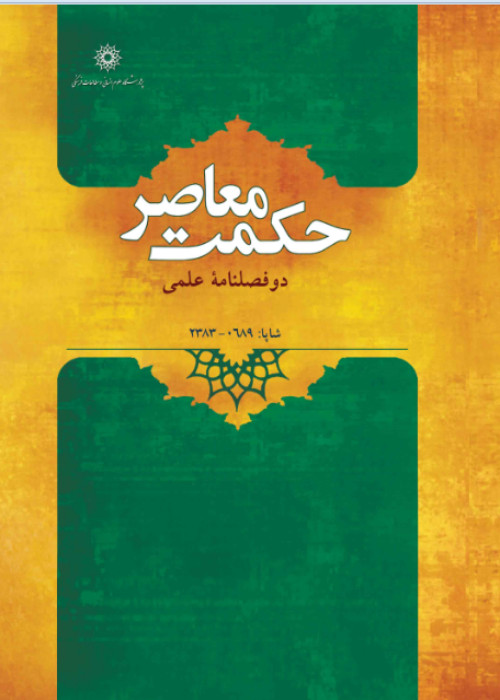Manifestation of Unity in the Imam Mosque of Isfahan according to Ibn ʿArabī’s Views
Human agency, both in creation and in recognition of architectural space and their interaction with the space, has been affected by the hidden harmony that is generated in the space, which turns the architectural space away from its static state, stillness, and lifelessness, and the core of the harmony is indeed the “unity”; that is, multiple parts find unity and totality within a whole that creates a sense inside, which fits the aesthetic desire and indeed the internal human self, because the human self seeks unity and suffers from multiplicity, diffusion, and conflicts (Ardalan et al., 2011). In fact, it might be acknowledged that architecture as a created work secretly involves the creation of multiplicity and turning it into unity in interaction with humans. Given the idea of the unity of existence (waḥdat al-wujūd) in Islamic mysticism, a world is portrayed that is, first, divine and spiritual, where the song of holiness resonates, and second, it involves a unity by which all multiple parts are unified, or more precisely speaking, all that exists is a manifestation or representation of the one unified reality. In this way, art in general and architecture in particular might come to have a different color. Unity of existence is evident in architectural work in the Islamic world, but the character of this unity is not adequately discussed. A genuine perception of unity in architectural space is not confined to external senses. To the contrary, in its higher degrees, i.e., internal senses, it affects the observer. The goal of the present research to identify the nature of this unity and how it occurs. The question of our research is as follows: are Ibn ʿArabī’s views of unity applicable to architectural space, and what material grounds are prepared in architectural space to attain the unity? To answer the question, we begin with an overview of Ibn ʿArabī’s mystical view, where the question of existence and knowledge of unity is discussed as the foundation of Ibn ʿArabī’s mysticism.According to our surveys, the issue of whether Ibn ʿArabī’s account of unity is applicable to architectural space has not been properly addressed in the past research. Instead, issues of the unity of existence and multiplicity within unity have been discussed separately in philosophy and architecture. Moreover, the architectural literature tends to focus on corporeal, visual, and symbolic aspects of architectural parts in the realization of unity. In the present research, we drawAssociate Professor, Department of Architecture, Faculty of Architecture and Urbanism, Tabriz Islamic Art University, Tabriz, Iran (Corresponding Author). This article has been extracted from the course "Wisdom in Islamic Architecture" in the Faculty of Architecture and Urbanism of Tabriz Islamic Art University. on Ibn ʿArabī’s views about the questions of existence and knowledge of unity as the foundation of his mysticism to tackle material and perceptual grounds in the Islamic architectural space to examine the move from multiplicity to unity.
Methodologically speaking, the present research is descriptive-analytic, adopting the qualitative research approach. Qualitative research involves identification of the relevant references, studies and overviews of the written sources, comprehension of their meanings, and extraction of the relevant material, establishment of relations between issues, and providing descriptions and analyses of them.
Creation of multiplicity in architectural space and its transformation into unity has been effective in attaining an understanding of the existential unity, such that this understanding in architectural space was a determinant of the degree of the work’s life, and was somehow a cause of its existence. In fact, to attain such a unity, the human presence and existence in the space is undoubtedly what engenders a motion toward its recognition. Accordingly, the move from multiplicity to unity in architectural space implies physical movement (translocation – ocular) and semantic movement (mental movement). During the movement in architectural space, the observer’s physical movement turns into visual movement, which in turn results in reception of a series of regression and connections in the observer’s mind, leading to his or her mental movement. However, once the observer begins to recognize and see signs, it enables him or her to move in the world of imagination to attain unity. In fact, genuine unity is obtained through human imagination.
There is a remarkable correspondence between perceptions of existential unity in both philosophy and architecture. On Ibn ʿArabī’s account, imagination is perception of images in the soul after having seen something. Indeed, imagination is the intermediary between dualities. So in his view, human imagination is capable of attaining unity in the world that is abstracted or detached from the sensible world (existence of multiplicity). Furthermore, in the unity of existence, finding the existence is the same as coming to exist, where the finding is through intuitions and revelations. In the Imam Mosque of Isfahan (or the Shah Mosque), manifestation of the pairs [imagination being in pair] in space provides a bedrock for the observer’s intuition and revelation of unity through a definition of hierarchies and qualitative geometry based on the principle of the centrality and symmetry and existence of light.
- حق عضویت دریافتی صرف حمایت از نشریات عضو و نگهداری، تکمیل و توسعه مگیران میشود.
- پرداخت حق اشتراک و دانلود مقالات اجازه بازنشر آن در سایر رسانههای چاپی و دیجیتال را به کاربر نمیدهد.


